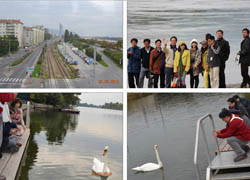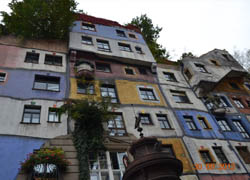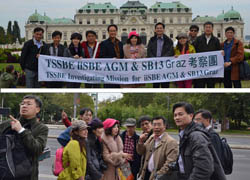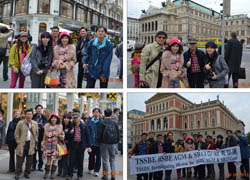Summary of iiSBE AGM & SB13 Graz (Part: 7)
 2013年9月30日一早從下榻的Leonardo Hotel出發前往老多瑙河區,一路上經過國會大廈、教堂、現代化玻璃帷幕牆大樓並橫越多瑙河,多瑙河上有遊輪穿梭,顯示遊多瑙河的行程仍受好評,也首次看到往市中心方向有稍微塞車景象,沿路街道牆面有少數塗鴉且以文字為主,精美的塗鴉圖畫則較少見,湖邊有零星獨棟住家,湖水清澈見底,正巧這時湖面游來一隻白天鵝及兩隻野鴨,一行人圍著白天鵝拍團體照或獨照,臨走前,發現河邊有垃圾分類收集及臨時性移動式廁所。 2013年9月30日一早從下榻的Leonardo Hotel出發前往老多瑙河區,一路上經過國會大廈、教堂、現代化玻璃帷幕牆大樓並橫越多瑙河,多瑙河上有遊輪穿梭,顯示遊多瑙河的行程仍受好評,也首次看到往市中心方向有稍微塞車景象,沿路街道牆面有少數塗鴉且以文字為主,精美的塗鴉圖畫則較少見,湖邊有零星獨棟住家,湖水清澈見底,正巧這時湖面游來一隻白天鵝及兩隻野鴨,一行人圍著白天鵝拍團體照或獨照,臨走前,發現河邊有垃圾分類收集及臨時性移動式廁所。On September 30, 2013, we set off in the morning from the Leonardo Hotel to the Old Danube region. On the way, we passed by the Austrian Parliament, cathedrals and buildings with modern glass facades before crossing the Danube River. Cruise ships could be seen sailing along the Danube showing that Danube River cruises remain quite popular. We also saw the first signs of traffic congestion in the direction of the city center. Very few of the walls along the streets had any graffiti and most of these consisted of text. Elaborate graffiti murals were quite rare. Along the lake, there were a few houses dotted here and there. The lake waters were so clear you could see the lake bottom. A white swan and two wild ducks happened to paddle by on the lake so everyone gathered around the swan to take photos or have their photos taken. As we got ready to leave, we noticed recycling bins and portable toilets next to the river.  在驅車前往百水公寓途中經過出租國宅,可長期租用,直到承租人放棄搬離為止,期間若沒有按時繳交租金,即要面臨強制搬離的命運。百水公寓以獨特的立面、不規則曲面及用色大膽設計著稱,現場同時聚集相當多的學生及觀光客,可以發現奧地利之所以有這麼多豐富的人文與藝術,創意構想不斷開發,應該就是將生活融入教育,讓維也納能成為歐洲著名的國際都市之一。 在驅車前往百水公寓途中經過出租國宅,可長期租用,直到承租人放棄搬離為止,期間若沒有按時繳交租金,即要面臨強制搬離的命運。百水公寓以獨特的立面、不規則曲面及用色大膽設計著稱,現場同時聚集相當多的學生及觀光客,可以發現奧地利之所以有這麼多豐富的人文與藝術,創意構想不斷開發,應該就是將生活融入教育,讓維也納能成為歐洲著名的國際都市之一。On the way to the Hundertwasser-haus we passed by public housing that can be rented on a long-term basis until as long as the renter wanted. They must however pay rent regularly or they will be evicted. Hundertwasserhaus is renowned for its unique frontage, irregular curves and bold colors. Many students and tourists were gathered in front of the building as well. They showed that Austria's wealth in art, culture and creativity probably came from making life a part of education and this in turn made Vienna one of the top international cities in Europe as well.  離開百水公寓後,直接前往哈布斯堡王朝興建的美泉宮,美泉宮已被列為聯合國教育科學文化組織的世界遺產,是維也納的重要標誌,花園以幾合圖案、精美的鐵鑄鐵件與繁複的線條設計,無不顯示哈布斯堡王朝的富裕及統治者的霸權宣示意味,花園整體以透水的細砂石及水池為主要元素,與末端的狩獵森林相呼應,相信是為騎馬通行方便而設計的。 離開百水公寓後,直接前往哈布斯堡王朝興建的美泉宮,美泉宮已被列為聯合國教育科學文化組織的世界遺產,是維也納的重要標誌,花園以幾合圖案、精美的鐵鑄鐵件與繁複的線條設計,無不顯示哈布斯堡王朝的富裕及統治者的霸權宣示意味,花園整體以透水的細砂石及水池為主要元素,與末端的狩獵森林相呼應,相信是為騎馬通行方便而設計的。After leaving Hundertwasserhaus, we went directly to the Schonbrunn Palace built by the House of Hapsburg. The Schonbrunn Palace has been listed by UNESCO as a World Heritage Site and is an important symbol of Vienna. The design of the garden features geometric patterns, exquisite cast iron pieces and complex lines that emphasized the House of Hapsburg's wealth and power. Fine permeable gravel and ponds defined the basic tone of the garden and complemented the hunting forest at the far end. This was undoubtedly designed for easy access by horses.  接著前往世界各國名牌林立的精品街,新舊文明的衝擊在廣告招牌上也各領風騷,另外高聳的歐洲第二大聖史蒂芬大教堂夾雜期間,碰巧聖史蒂芬大教堂正在整修無法入內參觀,廣場的設計、完整的徒步區規劃、街道中央低陷的排水系統與大石板舖面與歐洲其他國家相同,但是動輒百年以上的建築物或商店,及電車四通八達的程度令人印象深刻,在平均月收入2000歐元(相當新台幣8萬元)的奧地利,在高昂物價中,生活想必也並不輕鬆。 接著前往世界各國名牌林立的精品街,新舊文明的衝擊在廣告招牌上也各領風騷,另外高聳的歐洲第二大聖史蒂芬大教堂夾雜期間,碰巧聖史蒂芬大教堂正在整修無法入內參觀,廣場的設計、完整的徒步區規劃、街道中央低陷的排水系統與大石板舖面與歐洲其他國家相同,但是動輒百年以上的建築物或商店,及電車四通八達的程度令人印象深刻,在平均月收入2000歐元(相當新台幣8萬元)的奧地利,在高昂物價中,生活想必也並不輕鬆。We then went to the boutique street lined by famous international brands. The clash of old and new could be seen in the advertising signage as well. Mixed among them was St. Stephen Cathedral, the second largest cathedral in Europe. Our visit coincided with the refurbishing of St. Stephen Cathedral so we could not tour its interior. The design of the square, the fully-fledged pedestrian zone, the drainage system running along the shallow depression in the middle of the street and the stone slab paving were similar to those of other European countries. The buildings and shops that were frequently over a hundred years old as well as the trams that seemingly ran everywhere left a strong impression. The high cost of living however meant that living in Austria on an average monthly salary of 2,000 euros (equivalent to 80,000 NTD) couldn't be that easy. |

